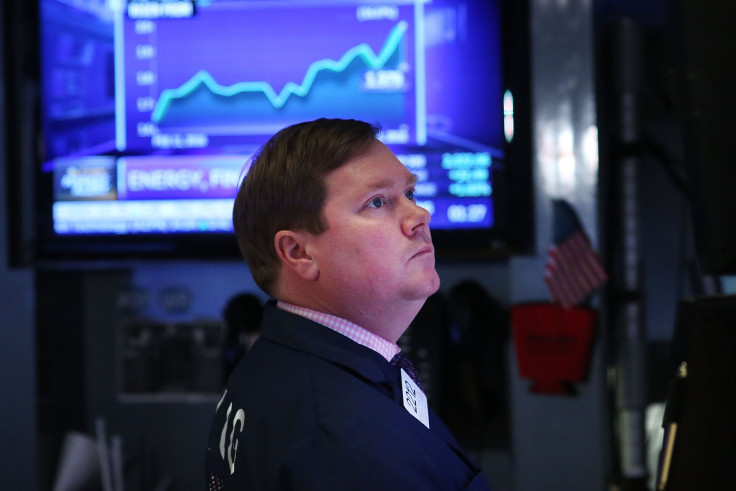Dow Jones Industrial Average Wavers Ahead Of Fed Decision; Oil Prices Rise On Lower US Inventory Data

This story was updated at 4:20 p.m. EDT.
U.S. stocks jumped Wednesday after U.S. Fed Chair Janet Yellen provided a positive outlook on the U.S. economy during the latest policy report, though stopping short of providing little more than a wait-and-see position on the next interest rate hike. The Standard & Poor's 500 index and Dow Jones Industrial Average closed at their highest points for the year.
“Economic activity has been expanding at a moderate pace despite the global economic and financial developments in recent months,” the Federal Open Market Committee of the central bank said.
The Dow (INDEXDJX:.DJI) gained 74.23 points, or 0.43 percent, to 17,325.76 by the closing bell in New York. The broader S&P 500 index (INDEXSP:.INX) rose 11.29 points, or 0.56 percent, to 2,027.22. The Nasdaq composite (INDEXNASDAQ:.IXIC) gained 35.30, or 0.75 percent, to 4,763.97, its highest level since Jan. 6.
Both the Dow and the S&P are down less than 1 percent since the start of the year and up over 8 percent and 9 percent, respectively, since their year-to-date dips on Feb. 11.
Eight out of the 10 S&P 500 sectors closed up Wednesday. Healthcare and financials stocks were down. Caterpillar Inc. (NYSE:CAT) led Dow advances while Pfizer Inc. (NYSE:PFE) led declines.
Earlier in the day, the U.S. Bureau of Labor Statistics released its latest inflation figures, a closely watched metric for determining further rate hikes later this year. Underlying inflation, which excludes volatile food and energy components, rose a higher-than-expected 0.3 percent in February. Economists polled by Thomson Reuters had expected a 0.2 percent increase. In the 12 months through February, the rate increased 2.3 percent, the largest rise since May 2012.
Despite a steep contraction in energy prices, which have fallen 12.5 percent in the 12 months ended February, Wednesday’s data helps build the argument for the U.S. Fed to remain on course to raise interest rates later this year. The topline inflation figure, which including energy and food components, rose 1 percent in the same period of time.
Data on housing constipation released before markets opened Wednesday was mixed.
The U.S. Census Bureau said new residential building construction increased more than expected in February, rising 5.2 percent to an annualized rate of 1.18 million units. Economists had expected a 4.6 percent rise to 1.15 million units. However, permits for new residential housing units fell 3.1 percent last month, to an annualized pace of 1.17 million, a larger-than-expected decline.
Meanwhile the U.S. Fed said Wednesday morning the country’s industrial production fell a larger than expected 0.5 percent last month after a 0.8 percent increase in the previous month. Analysts had expected a 0.3 percent decline. Industrial activity has fallen by 1 percent over the 12 months ended February. Manufacturing activity
Oil prices rallied Wednesday morning after a weekly private-sector estimate showed a lower-than-expected increase in crude inventories, by 1.5 million barrels in the week ended March 11. Analysts had expected a 3.4 million barrel increase. Official weekly inventory data released Wednesday morning also showed a lower-than-expected buildup of crude, by 1.3 million barrels versus the estimated 3.4 million barrels.
These inventory data plus an announcement that OPEC and non-OPEC oil producers would meet next month to discuss a production freeze cause a rally in oil futures on Wednesday.
U.S. West Texas Intermediate (WTI) gained 5.72 percent to $38.42 per barrel. Brent crude, the other major global benchmark, gained 3.85 percent to $40.23.
Asian stocks closed mixed with China’s broad CSI 300 Index of the mainland’s largest companies closing up 0.5 percent to 3,090. Hong Kong’s Hang Seng lost 0.15 percent to 20,258. Japan’s Nikkei lost 0.83 percent to 16,974. Australia’s S&P/ASX 200 gained 0.15 percent to 5,119 while South Korea’s main Kospi Index rose 0.25 percent to 1,975.
The broad pan-European Stoxx Europe 600 index edged up 0.16 percent in by the closing bell in Europe on Wednesday. The Paris-based CAC 40 lost 0.06 percent to 4,470 while London’s FTSE gained 0.72 percent to 6,184. Frankfurt’s DAX rose 0.65 percent to 9,999.
The benchmark U.S. 10-year Treasury touched 2.0 percent on Wednesday before dropping down to 1.92 percent by the closing bell, up from the previous day’s settle price of 1.97 percent. The bond yield typically rises when investors are more confident about the markets and falls when concerns flare. Gold, another so-called safe-harbor investment, gained 2.58 percent to $1,262.80 per troy ounce. Gold prices tend to rise as confidence in the markets falls.
© Copyright IBTimes 2024. All rights reserved.






















